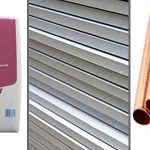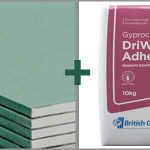If you have decided the walls in your home need improving, then one thing you might consider, is installing new plasterboards.
Using dot and dab, you can fit plasterboards relatively quickly, and easily. However, it’s not a case of just installing boards over any existing wall without prior consideration.
For example, you might have wallpaper on existing walls, and you may think the best option is to dot and dab boards on top. However, if you find yourself in this position, is it really a case of just installing them straight onto the paper? Or would this be a bad idea?

No, it’s not recommended that you dot and dab on wallpaper. This is because the paper is held on using wallpaper paste. While the wallpaper might feel secure, once you apply your dot and dab adhesive, the wallpaper will begin to lose its grip.
The adhesive that you use for dot and dab contains water. When this is added to the wallpaper, the water will cause the wallpaper to become loose and softer. This will eventually cause the wallpaper to lose its grip, which could lead to the plasterboards coming away from the walls.
Don’t Be Lazy! The Best Ways to Strip Wallpaper
It’s important that you spend time carrying out prep work, to ensure that your walls are ready for dot and dab.
If your walls have wallpaper, there is no use in trying to cut corners by leaving it on the wall.
This means that you should invest time in removing the wallpaper. Removing it will give you a completely bare wall that is ideal for fitting plasterboards over.
So, what methods can you use to strip the existing paper?
When it comes to removing wallpaper, you have two main options. The option you choose will depend on the scale of the job. It will also depend on how easy the existing wallpaper is to remove.
Your two options are:
- Using a steam wallpaper stripper
- Or using a chemical solution
Before you use these two options, you should prepare the wall by scoring the paper. This will enable the steam or solution to penetrate the wallpaper easily.
Steaming
If you opt for steam to strip your wallpaper, you will usually use a standard wallpaper steamer. This will have a hose and a steam plate. Firstly, you will need to fill the tank with water and allow it to heat up to boiling point.
Steam will eventually start coming out of the steam plate, which you can then hold against the wall. The steam eventually soaks through the scored wallpaper, reaching the adhesive. Now the adhesive will eventually soften and loosen, enabling the paper to come away from the wall with less effort.
Once the wallpaper and adhesive have softened, you can use a wallpaper scraper to work it away from the wall. Using the steam method is also highly effective when it comes to removing woodchip, which can be difficult to remove.
Chemical solution
The chemical solution involves using a liquid that you apply to the wallpaper. Most options are ready mixed, although some do need to be mixed with water. The solution is then sprayed onto the wallpaper.
The chemicals in the solution will eventually soften the adhesive, making it easier to remove the wallpaper from the wall using a scraper.
If you want your dot and dab plasterboards to fit firmly, then you should spend some time removing the paper properly. This will ensure the surface is ready to accept the dot and dab adhesive and form a strong bond.
How to Prep a Stripped Wall Before Dot and Dab
Until you remove the wallpaper, you don’t know what condition the wall is in underneath. However, it is likely that you will need to carry out some prep work. This will help your plasterboards to fit securely to the walls.
Under the wallpaper you are likely to find existing plaster. If the walls have any damage or cracks, you will need to fill these to create a smooth strong surface. This will help to create a strong bond when you dot and dab over the old plaster
Plaster also absorbs moisture, which means that it could suck the moisture out of your adhesive.
To create a better bond on the surface, and to ensure the existing plaster doesn’t suck up all the moisture in your dabs, you will need to use a weak water and PVA solution. One coat might be sufficient but if the surface is high suction, you may need to apply a second coat. Once the PVA is dry, you can then begin to install the dot and dab plasterboards.
Carrying out prep work might take time, but it will be worth it. It will ensure the wall is suitable for accepting the adhesive, and that will help to create a strong bond.
Conclusion
If you want to install plasterboards using dot and dab, it’s vital that you carry out the right prep work. It might seem tempting to save time and just install on top of the wallpaper, but eventually, the adhesive and the wallpaper will fail. This will result in your plasterboards coming away from the wall.
Therefore, you should spend time removing the wallpaper properly, as this will give you a clean surface that is suitable for applying your dot and dab adhesive to.




